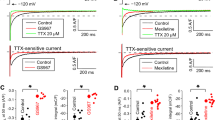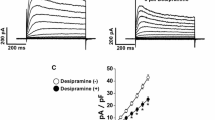Summary
The influence of the novel cardiotonic diphenylpiperazinylindole derivative. the racemic DPI 201-106. on cardiac Na+ channels was studied in conventional microelectrode experiments on papillary muscles of guinea pigs and in patch clamp experiments using inside-out patches excised from cultured neonatal rat cardiocytes. The maximal rate of rise (V max) of Na+-dependent action potentials was taken as an estimate for INa. Racemic DPI (3 × 10−6 mol/1) exerts a dual effect as it removes channel inactivation and may also block cardiac Na+ channels. Both drug actions proved highly voltage-dependent but a given change in membrane potential had a strictly different modulating influence on the two effects. The \0V max depression induced by racemic DPI became attenuated due to hyperpolarization and finally tended to disappear at about -90 mV. while at the same time I Na modification became increasingly accentuated. An increase in holding potential caused the non-decaying portion of the macroscopic I Na to increase significantly. Resting inactivation remained operative in non-inactivating cardiac Na+ channels and showed a similar voltage-dependence as in normal Na+ channels. The differential voltage-dependencies of both DPI effects strongly suggest the existence of two binding sites for DPI.
Similar content being viewed by others
References
Aldrich RW, Corey DP, Stevens CF (1983) A reinterpretation of mammalian sodium channel gating based on single channel recording. Nature 306:436–441
Blondel B, Roijen I, Cheneval JP (1971) Heart cells in culture: a simple method for increasing the portion of myoblasts. Experientia 27:356–358
Brown AM, Lee KS, Powell T (1981) Sodium current in single rat heart muscle cells. J Physiol (Loud) 318:479–500
Buggisch D, Isenberg G, Ravens U, Scholtysik G (1985) The role of sodium channels in the effects of the cardiotonic compound DPI 201–106 on contractility and membrane potentials in isolated mammalian heart preparations. Eur J Pharmacol 118:303–311
Carmeliet E (1984) Slow inactivation of the sodium current in rabbit cardiac Purkinje fibres. J Physiol (Loud) 353:125P
Cohen CJ, Bean BP, Colatsky TJ, Tsien RW (1981a) Tetrodotoxin block of sodium channels in rabbit Purkinje fibers. J Gen Physiol 78:383–411
Cohen I, Attwell D, Strichartz G (1981b) The dependence of the maximum rate of rise of the action potential on membrane properties. Proc Roy Soc Lond B214:85–98
Coraboeuf E, Deroubaix E, Coulombe A (1979) Effect of tetrodotoxin on action potentials of the conducting system in the dog heart. Am J Physiol 236:H561-H567
Hamill OP, Marty A, Neher E, Sakmann B, Sigworth FJ (1981) Improved patch-clamp techniques for high resolution current recording from cells and cell-free membrane patches. Pflügers Arch 391:85–100
Hille B (1977) Local anesthetics: hydrophilic and hydrophobic pathways for the drug-receptor reaction. J Gen Physiol 69:497–515
Hodgkin AL, Huxley AF (1952) Currents carried by sodium and potassium through the membrane of giant axon of Loligo. J Physiol (Lond) 116:449–472
Hondeghem LM, Katzung BG (1977) Time- and voltage-dependent interactions of antiarrhythmic drugs with cardiac sodium channels. Biochim Biophys Acta 472:373–398
Horn R, Vandenberg CA (1984) Statistical properties of single sodium channels. J Gen Physiol 84:505–534
Hunter PJ, McNaughton PA, Noble D (1975) Analytical model of propagation in excitable cells. Prog Biophys Mol Biol 30:99–144
Khodorov BI, Peganov EM, Revenko SV, Shishkova L (1975) Sodium currents in voltage-clamped nerve fiber of frog under the combined action of batrachotoxin and procaine. Brain Res 84:541–546
Kohlhardt M, Seifert C (1983) Tonic and phasic I Na blockade by antiarrhythmics. Different properties of drug binding to fast sodium channels as judged from \0V max studies with propafenone and derivatives in mammalian ventricular myocardium. With appendix by L. M. Hondeghem. Pflügers Arch 396:199–209
Kohlhardt M, Fröbe U, Herzig JW (1986) Modification of single cardiac Na+ channels by DPI 201–106. J Membr Biol 89:163–172
Mark GE, Strasser FF (1966) Pacemaker activity and mitosis in cultures of newborn rat heart ventricle cells. Expl Cell Res 44:217–233
Mason JW, Hondeghem LM, Katzung BG (1983) Amiodarone blocks inactivated cardiac sodium channels. Pflügers Arch 396:79–81
Nonner W, Spalding BC, Hille JB (1980) Low intracellular pH and chemical agents slow inactivation gating in sodium channels of muscle. Nature 284:360–363
Postma SW, Catterall WA (1984) Inhibition of binding of [3H] batrachotoxinin A 20-α-benzoate to sodium channels by local anesthetics. Mol Pharmacol 25:219–227
Quandt FN, Narahashi T (1982) Modification of single Na+ channels by batrachotoxin. Proc Natl Acad Sci USA 79:6732–6736
Quast U (1986) Interaction of the cardiac Na+ channel partial agonist DPI 201–106 with neural Na+ channels. NaunynSchmiedeberg's Arch Pharmacol 332 (Suppl):R51
Romey G, Quast U, Pauron D, Frelin C, Renaud JF, Lazdunski M (1987) Receptor site and mechanism of action on the voltagesensitive Na+ channel of a novel cardioactive agent DPI 201 106 and of its two enantiomers. (Submitted to Proc Natl Acad Sci USA)
Scholtysik G, Salzmann R, Berthold R, Herzig JW, Quast U, Markstein R (1985) DPI 201–106, a novel cardioactive agent. Combination of cAMP-independent positive inotropic, negative chronotropic, action potential prolonging and coronary dilatory properties. Naunyn-Schmiedeberg's Arch Pharmacol 329:316–325
Scholtysik G, Williams F (1986) Antiarrhythmic effects of DPI 201-106. Br J Pharmacol 87:75P
Starmer CF, Grant AO, Strauss HC (1984) Mechanisms of usedependent block of sodium channels in excitable membranes by local anesthetics. Biophys J 46:15–27
Vaughan-Williams EM (1975) Classification of antidysrhythmic drugs. Pharmacol Ther (B) 1:115–138
Wang GK, Brodwick MS, Eaton DC (1985) Removal of sodium channel inactivation in squid axons by the oxydant chloramine-T. J Gen Physiol 86:289–302
Author information
Authors and Affiliations
Additional information
This work was supported by a grant of the Deutsche Forschungsgemeinschaft (Ko 778/2-1). Bonn, Federal Republic of Germany
Send offprint requests to M. Kohlhardt at the above address
Rights and permissions
About this article
Cite this article
Kohlhardt, M., Fröbe, U. & Herzig, J.W. Removal of inactivation and blockade of cardiac Na+ channels by DPI 201-106 different voltage-dependencies of the drug actions. Naunyn-Schmiedeberg's Arch Pharmacol 335, 183–188 (1987). https://doi.org/10.1007/BF00177721
Received:
Accepted:
Issue Date:
DOI: https://doi.org/10.1007/BF00177721




